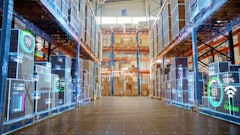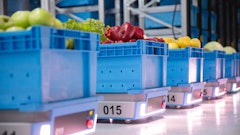
2024 is projected to be the year for major adoption and implementation of warehouse automation.
Thankfully, these true problem-solving solutions are prepping cold food chains for anything and everything.
Food Logistics talks exclusively with David Latona, president and CEO of Tompkins Solutions, about how companies can now utilize automation and robotics to solve the more complex tasks.
CLICK HERE to read the article in full.
Food Logistics: Warehouse automation continues to be on the rise. What do think is attributing to the growth in adoption of automated warehousing?
David Latona: Without a doubt it’s the increasing cost and availability of labor. Hourly labor rates continue to rise and did so on an exaggerated basis during COVID and those rates won’t go down, ever.
Even more challenging is the lack of accessible labor. Typical distribution center labor has a short learning curve due to the simplicity of most functions. Companies can now utilize automation and robotics to convert the more complex tasks to solve for the increasing labor shortage.
Food Logistics: What kinds of automated solutions/technologies has your company introduced within the last 12 months? Anything on the horizon that will be introduced soon?
Latona: Tompkins Solutions has been an early adopter of feeding one robotics system with another. By combining different technologies we’re offering unique solutions to our clients’ needs.
At MODEX, we’re introducing a very unique robotics company, which began in the food industry, to the logistics and CPG world. We think they’re going to have a substantial impact on future designs.
Food Logistics: What advice do you have for those companies who haven’t implemented any automation whatsoever or are just starting the journey? Where/how should they start?
Latona: They should start with the data first and foremost. Getting a clear and exact identification of their critical paths internally, and then extrapolating those with volume and growth to a realistic future-state environment should be completely mapped out prior to even considering automation/robotics of any sort.
Once they have a future-state destination to arrive at, they can explore a portion of their facility to automate. Jumping into a multi-million-dollar system from a baseline type system can be disastrous and should only include those concepts that have been properly evaluated.
Food Logistics: How can companies decipher which automated solutions are best for their warehouses?
Latona: Without the advice of an outside source who has successfully investigated and installed various types of automation and robotics, most companies will find the risks are not worth the reward. Work with someone who understands the pitfalls and can help navigate the project successfully.
The systems which will be the most advantageous will be obvious once the future needs are correctly identified and the hard discussions centered around operations integration are completed.
Food Logistics: In your opinion, which are the best types of automated solutions and why? Think AI, cloud-based, IoT, connectivity and more.
Latona: This is a tough question to answer as the correct solution is dependent on the individual needs. I do feel that goods-to-person solutions benefit almost everyone. For those a little less sophisticated, a true outbound dock sortation solution handling LTL, FTL and parcel is a definite must-have to make a positive effect on your labor. After that the sky is the limit.
Food Logistics: What are some things not addressed above that may be pertinent to our cold food chain readers?
Latona: Whatever state you may find yourself in, don’t be reluctant to ask for outside help. The perspective from someone outside your firm without the same day-to-day viewpoint will not only teach you something about your operations, but carries the “what works and what doesn’t” experience. They do for a living every day the type of project you’re just exploring. You wouldn’t jump into a car without knowing how to drive unless you took lessons…ask for the lessons here.
CLICK HERE to read the article in full.


























